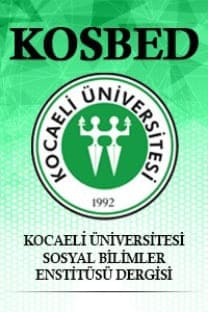Bilgi ve İletişim Teknolojileri Talebi: Bir Uygulama
Bilgi ve iletişim teknolojileri giderek artan bir şekilde günlük yaşama nüfuz etmektedir. Tüm iktisadi karar birimlerinin iktisadi davranışlarını önemli ölçüde etkileyen bilgi ve iletişim teknolojileri kullanılması her geçen gün artmaktadır. Bu nedenle tüketicilerin hangi bilgi ve iletişim teknoloji araçlarını ve ne sıklıkla kullandıklarını, bu araçları tercih ve talep etmelerinde etkili olan faktörleri belirlemek önem arz etmektedir. Bu amaç doğrultusunda hazırlanan çalışmada açımlayıcı faktör analizi, anova ve t testi analizi yapılmıştır. Yapılan analizler sonucunda gelir düzeyi, eğitim seviyesi ve ailede çalışan sayısı arttıkça bilgi ve iletişim teknolojilerine olan talebin arttığı görülmüştür. Aynı zamanda genç bireylerin, şehir merkezinde yaşayanların ve erkeklerin bilgi ve iletişim teknolojilerini daha çok talep ettikleri sonucuna varılmıştır
Anahtar Kelimeler:
Talep, bilgi ve iletişim teknolojileri talebi, faktör analizi
Demand for Information and Communication Technology: an Application
Information and communication technologies are increasingly permeates daily life. The use of information and communication technologies that significantly affects the economic behavior of all units of economic decision is increasing day by day. For this reason, which information and communication technology tools and how often they are used and the identification of factors which affect their choice and demand for these tools are so important. In this study prepared for achieving these objectives, exploratory factor analysis, ANOVA and t test analysis was performed. The results of analysis show that as the income level, education level and number of employees in the family increases, the demand for information and communication technologies are increasing, too. At the same time, it is concluded that young people, people living in the city center and men demand information and communication technologies more.
___
- Berberoğlu, Bahar (2010), “Yaşam Boyu Öğrenme İle Bilgi ve İletişim Teknolojileri Açısından Türkiye’nin Avrupa Birliği’ndeki Konumu”, Bilgi Ekonomisi ve Yönetimi Dergisi, 5(2): 113-126.
- Berberoğlu, Bahar (2010), “Bilgi Toplumu ve Bilgi Ekonomisi Oluşturma Yolunda Türkiye ve Avrupa Birliği”, Marmara Üniversitesi İ.İ.B.F. Dergisi, XXIX(II): 111-131.
- Best, M.L ve S.G. Maier (2007), “Gender, Culture and ICT Use in Rural South India”, Gender, Technology and Development, 11(2): 137-155.
- Beyit, Aysun (2006), Bilgi ve İletişim Teknolojilerinin Kentsel Sistemin Dönüşümüne Etkileri, (Basılmamış Yüksek Lisans Tezi), Selçuk Üniversitesi Sosyal Bilimler Enstitüsü, Konya.
- Dlodlo, Normusa (2009), “Access to ICT Education for Girls and Women in Rural South Africa: A Case Study”, Technology in Society, 31: 168-175.
- ECLAC Project Documents Collection, “Characteristics of Households with ICTs in Latin America and the Caribbean”, http://www.eclac. org/ddpe/publicaciones/xml/9/32189/W171.pdf /03.03.2011
- Erkan, H, Erkan, Canan. http://iibf.ogu.edu.tr/kongre/bildiriler/08-04.pdf /27.04.2011
- Government of the Gambia/Uneca Scan-ICT Country Report (2007), “Status of ICT Access, Usage and Exploitation in the Gambia Final Report”, http://www.scanict-gbos.gov.gm/docs/scan/scanictreport.pdf/03. 03. 2011
- Hanafizadeh, Mohammad Reza, Abbas Saghaei ve Payam Hanafizadeh (2009), “An Index for Cross-Country Analysis of ICT Infrastructure and Access”, Telecommunications Policy, 33: 385-405.
- Hjorthol, Randi ve Mattias Gripsrud (2009), “Home as a Communication Hub: The Domestic Use of ICT”, Journal of Transport Geography, 17: 115-123. http://tuikapp.tuik.gov.tr/adnksdagitapp/adnks.zul/27.03 .2011
- Hull, B. (2003), “ICT And Social Exclusion: The Role of Libraries”, Telematics and Informatics, 20: 131-142.
- Karahan Uslu, Zeynep (2007). “Yeni İletişim Araçları ve Toplumsal Etkileri”, Sosyoloji Araştırmaları Dergisi, 1: 1-11.
- Odendaal, Willem, Charles Malcolm, Shazly Savahl and Rose September (2006), “Adolescents, Their Parents, and Information and Communication Technologies: Exploring Adolescents’ Perceptions on How These Technologies Present in Parent-Adolescent Relationships”, Indo-Pacific Journal of Phenomenology, 6: 1-8.
- OECD (2007), “ICTs and Gender”, http://www.oecd.org/dataoecd/16/33/ 38332121.pdf / 27.03.2011
- Robertson, Alastair, Didier Soopramanien and Robert Fildes (2007), “A Segment-Based Analysis of Internet Service Adoption among UK Households”, Technology in Society, 29: 339-350.
- Rİpke, Inge, Toke Christensen, Jensen Haunstrup and Ole Jesper (2010), “Information and Communication Technologies- A New Round of Household Electrification”, Energy Policy, 38: 1764-1773.
- Salman, Ali and Mohd Safar Hasim (2009), “Sustainability of Internet Usage: A Study among Malay Women in a Sub-Urban Setting in Malaysia”, European Journal of Social Sciences, 9(3): 433-447.
- Tengtrakul, Pitikon and Jon M. Peha (2011), “Access to And Penetration of ICT in Rural Thailand”, Telecommunications Policy, 35: 141-155.
- Thomée, Sara, Mats Eklöf, Ewa Gustafsson, Ralph Nilsson and Mats Hagberg (2007), “Prevalence of Perceived Stress, Symptoms of Depression and Sleep Disturbances in Relation to ICT Use among Young Adults an Explorative Prospective Study”, Computers in Human Behavior, 24: 1300-1321.
- Timisi, Nilüfer (2003), Yeni İletişim Teknolojileri ve Demokrasi, Dost Kitabevi, Ankara.
- Yamane, Taro (1967), Statistics: An Introductory Analysis, Harper &Row, New York.
- Yılmaz, Kürşad ve M. Barış Horzum (2005), “Küreselleşme, Bilgi Teknolojileri ve Üniversite”, Eğitim Fakültesi Dergisi, 6(10): 103-121.
- Youtie, Jan, Philip Shapira and Greg Laudeman (2007), “Supply, Demand and ICT- Based Services: A Local Level Perspective”, Telecommunications Policy, 31: 347-358.
- Kocaeli University Journal of the Institute of Social Sciences, 2012, 23 : 49 - 68
- DEMAND FOR INFORMATION AND COMMUNICATION
- TECHNOLOGY: AN APPLICATION Selahattin KAYNAK* Zeynep KARACA**
- ISSN: 1302-6658
- Başlangıç: 1997
- Yayıncı: Kocaeli Üniversitesi
Sayıdaki Diğer Makaleler
Bilgi ve İletişim Teknolojileri Talebi: Bir Uygulama
Selahattin KAYNAK, Zeynep KARACA
Türkiye'de KOBİ’lere Yapılan Destekler ve İstihdam Üzerindeki Etkileri
Dede Korkut Hikâyelerindeki Alkış ve Kargışlara İşlevsel Bir Yaklaşım
Varlık ve Yokluk Arasında Universitas'in Tarihüstü Sentezi
Sağlık İşletmelerinde Etkinlik Analizi: Kocaeli Örneği
Yusuf BAYRAKTUTAN, Ferhat PEHLİVANOĞLU
Doğrudan Yabancı Yatırımların Dünya’daki ve Türkiye’deki Gelişimi
Cahit AYDEMİR, İbrahim ARSLAN, Funda UNCU
Psikolojik Güçlendirmenin Örgütsel Vatandaşlık Davranışına Etkisi Üzerine Bir Araştırma
